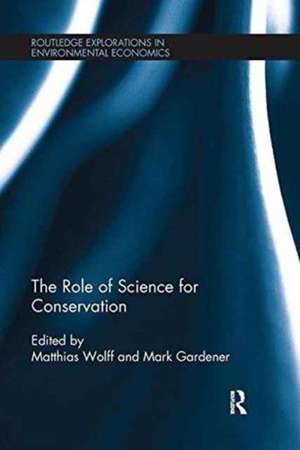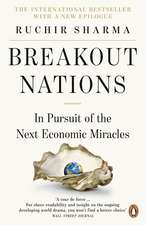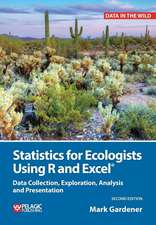The Role of Science for Conservation: Routledge Explorations in Environmental Economics
Editat de Matthias Wolff, Mark Gardeneren Limba Engleză Paperback – 9 dec 2016
| Toate formatele și edițiile | Preț | Express |
|---|---|---|
| Paperback (1) | 331.87 lei 6-8 săpt. | |
| Taylor & Francis – 9 dec 2016 | 331.87 lei 6-8 săpt. | |
| Hardback (1) | 797.37 lei 6-8 săpt. | |
| Taylor & Francis – 9 feb 2012 | 797.37 lei 6-8 săpt. |
Din seria Routledge Explorations in Environmental Economics
-
 Preț: 311.58 lei
Preț: 311.58 lei -
 Preț: 311.18 lei
Preț: 311.18 lei -
 Preț: 314.71 lei
Preț: 314.71 lei - 25%
 Preț: 823.26 lei
Preț: 823.26 lei - 18%
 Preț: 1053.92 lei
Preț: 1053.92 lei -
 Preț: 424.58 lei
Preț: 424.58 lei - 15%
 Preț: 431.75 lei
Preț: 431.75 lei - 17%
 Preț: 289.78 lei
Preț: 289.78 lei - 18%
 Preț: 1403.97 lei
Preț: 1403.97 lei - 28%
 Preț: 827.23 lei
Preț: 827.23 lei -
 Preț: 329.92 lei
Preț: 329.92 lei - 18%
 Preț: 1223.61 lei
Preț: 1223.61 lei -
 Preț: 420.30 lei
Preț: 420.30 lei - 26%
 Preț: 848.93 lei
Preț: 848.93 lei - 18%
 Preț: 1272.54 lei
Preț: 1272.54 lei - 25%
 Preț: 797.37 lei
Preț: 797.37 lei - 18%
 Preț: 1288.46 lei
Preț: 1288.46 lei -
 Preț: 416.05 lei
Preț: 416.05 lei -
 Preț: 279.72 lei
Preț: 279.72 lei -
 Preț: 378.43 lei
Preț: 378.43 lei - 18%
 Preț: 1286.01 lei
Preț: 1286.01 lei -
 Preț: 422.04 lei
Preț: 422.04 lei - 18%
 Preț: 1061.93 lei
Preț: 1061.93 lei - 18%
 Preț: 1060.25 lei
Preț: 1060.25 lei -
 Preț: 493.80 lei
Preț: 493.80 lei - 18%
 Preț: 1336.46 lei
Preț: 1336.46 lei - 18%
 Preț: 1065.06 lei
Preț: 1065.06 lei - 26%
 Preț: 821.46 lei
Preț: 821.46 lei - 25%
 Preț: 1022.48 lei
Preț: 1022.48 lei - 18%
 Preț: 1226.37 lei
Preț: 1226.37 lei -
 Preț: 393.26 lei
Preț: 393.26 lei -
 Preț: 418.22 lei
Preț: 418.22 lei - 28%
 Preț: 824.53 lei
Preț: 824.53 lei - 18%
 Preț: 1169.16 lei
Preț: 1169.16 lei - 18%
 Preț: 1380.52 lei
Preț: 1380.52 lei -
 Preț: 485.61 lei
Preț: 485.61 lei - 18%
 Preț: 1285.17 lei
Preț: 1285.17 lei -
 Preț: 398.44 lei
Preț: 398.44 lei - 18%
 Preț: 1067.84 lei
Preț: 1067.84 lei - 12%
 Preț: 303.64 lei
Preț: 303.64 lei
Preț: 331.87 lei
Preț vechi: 379.25 lei
-12% Nou
Puncte Express: 498
Preț estimativ în valută:
63.51€ • 67.91$ • 52.95£
63.51€ • 67.91$ • 52.95£
Carte tipărită la comandă
Livrare economică 17 aprilie-01 mai
Preluare comenzi: 021 569.72.76
Specificații
ISBN-13: 9781138243866
ISBN-10: 1138243868
Pagini: 320
Ilustrații: 158
Dimensiuni: 156 x 234 mm
Greutate: 0.45 kg
Ediția:1
Editura: Taylor & Francis
Colecția Routledge
Seria Routledge Explorations in Environmental Economics
Locul publicării:Oxford, United Kingdom
ISBN-10: 1138243868
Pagini: 320
Ilustrații: 158
Dimensiuni: 156 x 234 mm
Greutate: 0.45 kg
Ediția:1
Editura: Taylor & Francis
Colecția Routledge
Seria Routledge Explorations in Environmental Economics
Locul publicării:Oxford, United Kingdom
Public țintă
Postgraduate and UndergraduateCuprins
Part 1: The Evolutionary Context 1.1. What Darwin Found Convincing in Galapagos William Durham 1.2. Research on Evolutionary Principles in Galapagos: Research on Evolutionary Principles in Galapagos: An Overview of the Past 50 Years Carloss Valle and Patricia G. Parker 1.3. Evolution of Pathogens and Parasites on the Galapagos Islands Patricia G. Parker and Noah K. Whiteman 1.4. Turning Points in the Evolution of Vertebrates Eibl-Eibesfeld 1.5. The Boat, the Bay, and the Museum: Significance of the 1905-1906: Galapogos Expedition of the California Academy of Sciences Matthew James 1.6. Chapter Summary Part 2: Biodiversity Assessment and Monitoring of Change 2.1. Monitoring the Galapagos Ecosystem: Challenges, Pitfalls and a Vision for the Future James P. Gibbs and Bryan Milstead 2.2. The Neglected Majority – Biodiversity Inventories as an Integral Part of Conservation Biology Frank Bungartz 2.3. The Power of Long-Term Monitoring to Understand Mechanisms of Ecosystem Change: the Case of the Galapagos Marine Reserve Stuart Banks, Rodrigo Bustamante, Diego Ruiz, Natalia Tirado, Mariana Vera and Franz Smith 2.4. Wildlife Health Monitoringand Disease Management Protecting the Biodiversity of Galapagos Patricia G. Parker and Sharon L. Deem 2.5. Chapter Summary Part 3: A Systemic Approach: Modeling and Restoration 3.1. A Review of 40 Years of Eradication Programs in Galapagos: Impacts on the Whole Ecosystem Rachel Atkinson, Mark Gardener, Grant Harper and Victor Carrion 3.2. Food Web Structure of the Galapogas Pelagic Econosystem after a Decade of Protective Insights from Trophic Modelling Matthias Wolff and Cesar Peñaherrera 3.3. Mediated Modelling: A System Dynamics Approach To Environmental Consensus Building for the Galapagos Marjan van den Belt 3.4. Chapter Summary Part 4: Reconciliation of the Conservation with Socio-Economic Development 4.1. The Value of Ecosystem Services and Biodiversity Conservation: A Challenge for the Galapagos Robert Costanza
Notă biografică
Matthias Wolff is Director of Marine and Coastal Sciences at the Charles Darwin Foundation, Puerto Ayora, Ecuador.
Mark Gardener is Director of Terrestrial Science at the Charles Darwin Foundation, Puerto Ayora, Ecuador.
Mark Gardener is Director of Terrestrial Science at the Charles Darwin Foundation, Puerto Ayora, Ecuador.
Descriere
The book integrates the knowledge and reflections of thirty scientists, of which many have dedicated a substantial part of their professional life to the Galapagos archipelago, to the conservation of its biodiversity and to the sustainable management of its resources. The book can be considered a milestone on the way to the successful conservation and sustainable development of this unique world heritage site.

















